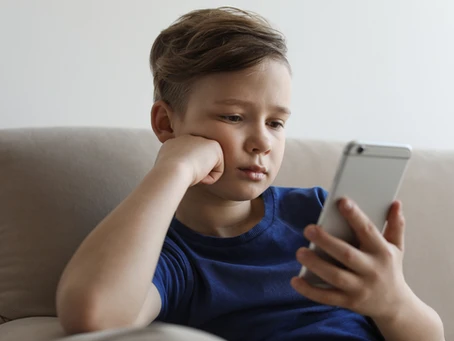
COVID-19 has forced many of us to change our behaviours – for children and youth in crucial developmental stages, the pandemic has also had a devasting impact on their social development. In light of the health crisis and keeping people safe, many of us who work on the frontlines of the mental health field are starting to see the effects of the lockdown. It has undoubtedly impacted the emotional well-being of children, youth, teens, and adults. Although the psychological impacts of the lockdown remain unclear, research indicates that there are negative implications on individual mental health.
Identifying At-Risk Children
In the mental health field, we refer to children who may be at risk for a mental health condition as subclinical. In other words, the child doesn’t quite meet all the criteria required for a diagnosis, but it’s important to begin a period of “watchful waiting” or active surveillance. Children who were identified as being “at risk” or subclinical when COVID-19 first hit are now meeting the criteria for a formal diagnosis. The likely cause? The pandemic.
The Diathesis-Stress Model
A common model used in psychology is the diathesis-stress model. This model explains how individuals may have a predisposition, based on genetic factors, for a certain diagnosis. When the predispositions interact with a series of stressors like the current health pandemic, the genes turn on, and the individual symptoms increase. Anecdotally, there has been an increase in social anxiety, particularly among children and teens.
Understanding Social Anxiety
Social anxiety is often overlooked and seen as a child being shy or a phase they may go through as they approach adolescence. However, an extreme fear of social situations that typically leads to avoidance of people and interactions is much more than a personality trait. According to the National Social Anxiety Center, individuals who suffer from social anxiety “avoid situations that are important or endure them with a great deal of distress.” In children and teens, it can be fear that causes them to avoid eye contact, speaking to others, talking on the phone, and going out in public, leading to extreme fear and avoidance of leaving the house. Anxiety Canada indicates that social anxiety peaks during adolescence and can be triggered by a stressful or embarrassing situation. COVID-19 would certainly fit the criteria for a stressful situation.
Symptoms of Social Anxiety: Before and After COVID-19
Before COVID-19
- Physical symptoms of blushing, nausea, stomach aches, “butterflies,” sweaty palms, and other physical symptoms in anticipation of having to interact with others, including going to school, playdates, and extracurricular activities.
- May have expressed an unwillingness or concerns regarding public places and interactions but still continued to go out.
After Lockdown
- Avoidance and extreme fear of resuming regular activities such as school, playdates, birthday parties, extracurricular activities, and talking on the phone.
- Emotional meltdowns and regulation struggles in thinking about being around people.
- Refusal to leave the house and extreme emotional outbursts in anticipation of leaving the house.
- Possible symptoms of depression.
- Increased need to be close to primary caregivers.
- Avoidance of eye contact.
- Reliance upon caregiver to communicate with others on behalf of themselves.
- Increased somatic experiences, including vomiting.
- Refusal to leave the house, or will only go places if their caregivers accompany them.
- Refusal to engage in conversation on the phone, a significant decrease in interactions with others, or complete avoidance of people and social interactions.
Treating Social Anxiety Through Exposure
One of the ways that social anxiety is treated is through exposure. The difference between pre-COVID-19 and post-lockdown is a lack of practice for anxiety-related activities. Exposure involves engaging in an activity that causes some distress but can be successfully managed by increasing the frequency and duration of being in a situation that causes anxiety or fear. When children and youth are placed in a situation where they can no longer practice exposure, the fear is able to grow. The cyclical nature of avoiding the feared stimuli results in the reinforcement of the behavior. This ultimately causes an increase in distress when the feared stimuli need to be confronted.
Strategies to Prevent Social Anxiety from Increasing
The act of going to school, spending time with friends, or ordering ice cream can become so distressing that the child’s brain becomes emotionally flooded. Then the cycle repeats again. In many cases, the fear and distress of interacting with others have grown to a level where even attending counseling to obtain support and treatment provokes anxiety and fear. The child or teen is afraid to talk, cannot make eye contact, and breaks down in tears. The mere idea of having to interact with others causes such distress that it may lead to agoraphobia. The lockdown and ongoing pandemic are a breeding ground for perpetuating social anxiety. Here are some strategies to prevent social anxiety from increasing:
Maintain Face-to-Face Contact
Find ways for the child to continue to have face-to-face contact with people. For example, engaging in regular video calls.
Monitor Avoidance Behaviors
Notice if they are starting to avoid people and places. If so, find ways for them to practice that skill, such as going for walks or riding their bike.
Encourage Communication
Ensure the child is not avoiding communication with others. When possible, get them to practice ordering from restaurants, drive-throughs, etc.
Work on Nonverbal Skills
Work on their nonverbal skills, such as making eye contact with others and smiling.
Prevention and Professional Support
Lastly, prevention is key to addressing the possibility of social anxiety from increasing. Connect with a mental health therapist who can support the child in mitigating their negative thought patterns and avoidance.
Through the use of different models such as cognitive-behavioral therapy, exposure therapy, and other well-studied approaches, social anxiety can be managed, and children and teens can resume their regular functioning. Identifying the feared stimuli should be explored first so a proper approach can be provided to the child or youth.




